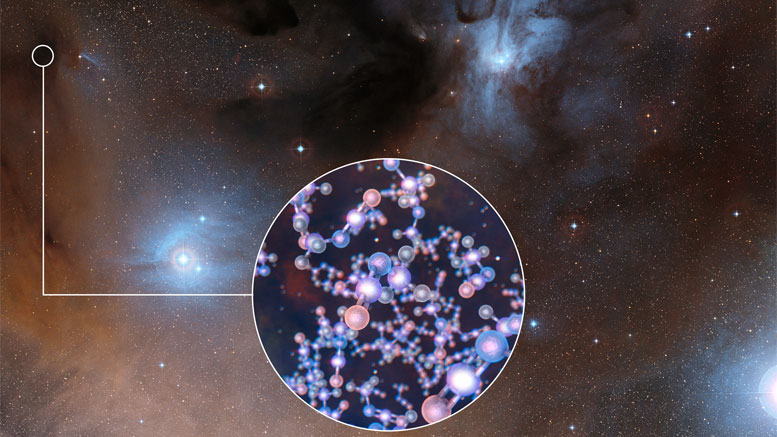
This image shows the spectacular region of star formation where methyl isocyanate was found. The insert shows the molecular structure of this chemical. Credit: ESO/Digitized Sky Survey 2/L. Calçada
Using ALMA, astronomers have found traces of methyl isocyanate — a chemical building block of life – around Sun-like stars at a very early stage in their formation. This is the first-ever detection of this prebiotic molecule towards a solar-type protostar, the sort from which our Solar System evolved. The discovery could help astronomers understand how life arose on Earth.
Two teams of astronomers have harnessed the power of the Atacama Large Millimeter/submillimeter Array (ALMA) in Chile to detect the prebiotic complex organic molecule methyl isocyanate in the multiple star system IRAS 16293-2422. One team was co-led by Rafael Martín-Doménech at the Centro de Astrobiología in Madrid, Spain, and Víctor M. Rivilla, at the INAF-Osservatorio Astrofisico di Arcetri in Florence, Italy; and the other by Niels Ligterink at the Leiden Observatory in the Netherlands and Audrey Coutens at University College London, United Kingdom.
“This star system seems to keep on giving! Following the discovery of sugars, we’ve now found methyl isocyanate. This family of organic molecules is involved in the synthesis of peptides and amino acids, which, in the form of proteins, are the biological basis for life as we know it,” explain Niels Ligterink and Audrey Coutens.
ALMA’s capabilities allowed both teams to observe the molecule at several different and characteristic wavelengths across the radio spectrum. They found the unique chemical fingerprints located in the warm, dense inner regions of the cocoon of dust and gas surrounding young stars in their earliest stages of evolution. Each team identified and isolated the signatures of the complex organic molecule methyl isocyanate. They then followed this up with computer chemical modeling and laboratory experiments to refine our understanding of the molecule’s origin.
IRAS 16293-2422 is a multiple system of very young stars, around 400 light-years away in a large star-forming region called Rho Ophiuchi in the constellation of Ophiuchus (The Serpent Bearer). The new results from ALMA show that methyl isocyanate gas surrounds each of these young stars.
Earth and the other planets in our Solar System formed from the material left over after the formation of the Sun. Studying solar-type protostars can therefore open a window to the past for astronomers and allow them to observe conditions similar to those that led to the formation of our Solar System over 4.5 billion years ago.
Rafael Martín-Doménech and Víctor M. Rivilla, lead authors of one of the papers, comment: “We are particularly excited about the result because these protostars are very similar to the Sun at the beginning of its lifetime, with the sort of conditions that are well suited for Earth-sized planets to form. By finding prebiotic molecules in this study, we may now have another piece of the puzzle in understanding how life came about on our planet.”
Niels Ligterink is delighted with the supporting laboratory results: “Besides detecting molecules we also want to understand how they are formed. Our laboratory experiments show that methyl isocyanate can indeed be produced on icy particles under very cold conditions that are similar to those in interstellar space This implies that this molecule — and thus the basis for peptide bonds — is indeed likely to be present near most new young solar-type stars.”
References:
- “First Detection of Methyl Isocyanate (CH3NCO) in a solar-type Protostar” by R. Martín-Doménech, V. M. Rivilla, I. Jiménez-Serra, D. Quénard, L. Testi and J. Martín-Pintado, 17 April 2017, MNRAS.
DOI: 10.1093/mnras/stx915
arXiv - “The ALMA-PILS survey: Detection of CH3NCO toward the low-mass protostar IRAS 16293-2422 and laboratory constraints on its formation” by N. F. W. Ligterink, A. Coutens, V. Kofman, H. S. P. Müller, R. T. Garrod, H. Calcutt, S. F. Wampfler, J. K. Jørgensen, H. Linnartz and E. F. van Dishoeck, 17 April 2017, MNRAS.
DOI: 10.1093/mnras/stx890
arXiv

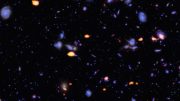
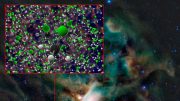
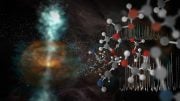
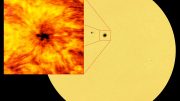
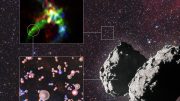
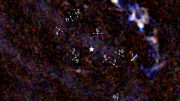
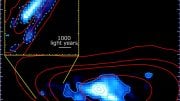
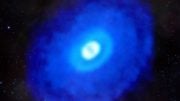
Be the first to comment on "Astronomers Discover Ingredient of Life Around Infant Sun-Like Stars"